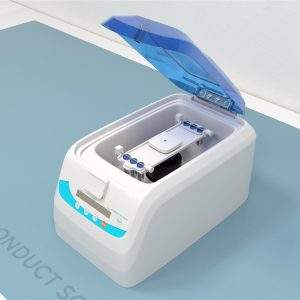$0.00
Is an essential piece of equipment in histology laboratories, designed to smooth out wrinkled paraffin wax tissue sections after cutting. It provides a warm water bath with a non-stick coating and a precise temperature control system.

Conduct Science is a premier manufacturer of research infrastructure, born from a mission to standardize the laboratory ecosystem. We combine industrial-grade precision with a scientist-led tech-transfer model, ensuring that every instrument we build solves a real-world experimental challenge. We replace "home-brew" setups with validated tools ranging from microsurgical suites to pathology systems. With a track record of >1,600 institutional partners and hundreds of citations, our equipment is engineered to minimize human error. We help you secure more data for less of your budget, delivering the reliability required for high-impact publication.

bool(false)


The RF-XH-1001 Tissue Flotation Bath is an essential piece of equipment in histology laboratories, designed to smooth out wrinkled paraffin wax tissue sections after cutting. It provides a warm water bath with a non-stick coating and a precise temperature control system. This ensures that the tissue sections flatten out completely before they are mounted onto microscope slides, a critical step for preparing high-quality samples for microscopic examination. The device features an intelligent digital display for easy temperature monitoring and control.
Parameter | Value |
Model | RF-XH-1001 |
Display | LED Digital Display |
Product Size | L340mm x W340mm x H110mm |
Heating Material | Carbon Fiber |
Temperature Range | Ambient to 90° |
Temperature Precision | ±1°C |
Capacity | 2000ml |
Voltage & Frequency | AC220V±10% - 50Hz±1Hz |
A tissue flotation bath, also known as a histology water bath, is a laboratory instrument used to float and flatten out paraffin sections. After a tissue block is cut on a microtome, the resulting sections often have wrinkles or folds. Placing these sections on the surface of a warm water bath causes the paraffin wax to soften and the tissue to expand and flatten out. This process is vital for creating a smooth, artifact-free sample that can be easily mounted onto a glass slide. The controlled temperature of the water bath is crucial to ensure the paraffin softens just enough without melting completely, which would compromise the integrity of the tissue section.

In the preparation of histological samples, a key step after microtomy is the flattening of tissue sections. This procedure is performed using a tissue flotation bath. The RF-XH-1001 is designed to provide an optimal environment for this task, utilizing a carbon fiber heating element to ensure even and rapid heat distribution. By providing a stable and accurate temperature, it helps technicians efficiently prepare slides for staining, ultimately leading to more accurate and reliable diagnostic results. The instrument’s simple operation and robust design make it a reliable tool for any histopathology workflow.
Parameter | Value |
Model | RF-XH-1001 |
Display | LED Digital Display |
Product Size | L340mm x W340mm x H110mm |
Heating Material | Carbon Fiber |
Temperature Range | Ambient to 90° |
Temperature Precision | ±1°C |
Capacity | 2000ml |
Voltage & Frequency | AC220V±10% - 50Hz±1Hz |
The main components of a tissue flotation bath are:
Water Bath: The basin or tank that holds the water where the tissue sections are floated.
Heating Element: The internal component responsible for heating the water. In the XH-1001, this is a carbon fiber material.
Control Panel: The interface with an LED digital display and control buttons for setting and monitoring the temperature.
Temperature Sensor: A probe or sensor located in the bath to provide real-time temperature feedback to the control unit.
Casing: The outer housing of the device, which protects the internal components and provides a stable base.
Improved Sample Quality: Effectively flattens tissue sections, eliminating wrinkles and folds that could interfere with microscopic analysis.
Efficiency: The controlled heating and large capacity (2000ml) allow for the quick processing of multiple samples at once.
Consistency: Provides a uniform temperature, which ensures reproducible results from one sample to the next.
User-Friendly Design: Simple digital controls and an easy-to-clean tank streamline the workflow.
Risk of Contamination: If the water is not changed frequently, it can become a source of contamination for tissue samples.
Limited Functionality: The device is designed for a single, specific purpose (flotation) and cannot be used for other lab tasks.
Melting Point Variation: Users must manually set the temperature based on the specific type of paraffin wax used, as different waxes have different melting points. Incorrect temperature can damage the tissue.
Gephardt, G. N., & Zarbo, R. J. (1991). Extraneous tissue (floaters) in surgical pathology. A college of American Pathologists Q-Probes study of 1,125 cases from 65 institutions. American Journal of Clinical Pathology, 95(5), 767–772. https://academic.oup.com/ajcp/article/136/5/767/1766314
Ronald P. Spark, Quality Assurance in Surgical Pathology, American Journal of Clinical Pathology, Volume 76, Issue 3, 1 September 1981, Page 364, https://doi.org/10.1093/ajcp/76.3.364
| Dimensions | 340 × 340 × 110 cm |
|---|
There are no questions yet. Be the first to ask a question about this product.